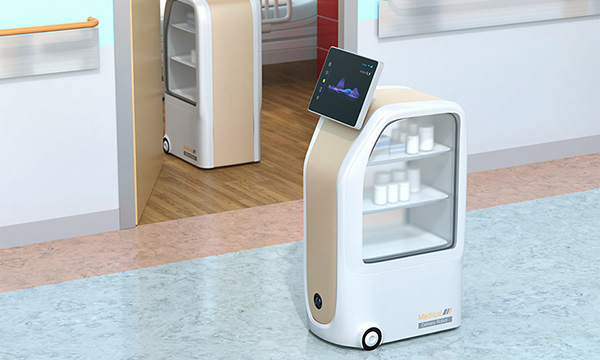The introduction of autonomous robots and artificial intelligence (AI) has the power to change the way businesses operate.
By Andrew Zarkowsky, Head of Artificial Intelligence Underwriting, The Hartford
For example, warehouses are reducing the risk of workplace injuries by having robots complete higher hazard tasks such as carrying heavy materials or entering workspaces that would require humans to wear protective gear to guard against noise or toxic chemicals. However, as technology continues to rapidly evolve, it is important to understand both the risks and the benefits of introducing autonomous robots into operations.
According to a 2024 Industrial Robot report by Interact Analysis, nearly 21% of warehouses use some form of robotics, up from 15% in 2018. In addition, robots are being used across a variety of other industries, including:
While autonomous robots are intelligent machines that can perform tasks such as finding and picking items in a distribution center or sanding fiberglass at a construction site, to do the job right, robots need sensors and visual data to make decisions and operate autonomously. And sometimes, they also need human intervention to keep them on track. Despite these limitations though, robots give workers the ability to delegate mundane and hazardous tasks to machines, allowing humans to focus on the more engaging and valuable parts of their job. Robots are not constrained by heat or chemicals and can be used to perform tasks that are potentially dangerous to humans. For example, robots with sensors can venture into a high-hazard area to check for radioactivity or diminished air quality.
Companies are also using robots for overnight security. They can drive around the parking lot of a vacant building, for instance, to show a presence of security, record events and hopefully be able to prevent a bad actor from causing an issue. In addition, robots are taking on other meaningful tasks in the workforce such as delivering bedding for an on-call nurse in a hospital or bringing material to a nurse, so he or she does not need to step away from a patient.
Robots, however, are not infallible. In addition to potentially breaking down, autonomous robots can perform the wrong action if not programmed correctly. Robots have been known to go off course and end up in the wrong section of a warehouse or get stuck on a loading dock. And if the robots are interacting with humans, the risks increase.
Companies considering the use of robots should assess the work environment and every individual task a robot would complete. A controlled environment such as a warehouse entails less risk than a robot functioning outside on a public road.
When using autonomous robots, a company should evaluate its risk based on the environment and concurrently evaluate insurance coverage – particularly general liability, workers’ compensation, property, professional liability (also called Technology Errors & Omissions or Tech E&O) and cyber liability. There is a risk correlation to the environment and the end use. It is important that the users of the robot understands their liability and the availability of appropriate insurance coverage.
The business should spend a lot of time thinking about risk transfer and understanding the contract wording in the SOW (Statement of Work) who is responsible for what. It is important to make sure there is a very clear picture of expectations and warranties and how the insurance will provide or exclude coverage. If something goes wrong, the insurer will evaluate whether it was caused by the manufacturer’s design, or if the company using the robots designed the constraints incorrectly.

If a company is considering the use of robots in operations, do not let risk be a deterrent. Waiting to use robots can be its own risk, hindering a company’s productivity and innovation. Companies should start to do something if it is appropriate to their business. The ramp up time from not having robotics in the workplace to having them is significant. It might take years to use the robot efficiently. With that insight, here are some steps to consider:
When initiating a robot program, business should consider hiring someone internally to oversee the initiative or bring on a consultant who deeply understands what is involved. It will take a true combination of understanding the business and process, as well as understanding AI and robotics. Just having one or the other will not be sufficient.
Insurance carriers, in partnership with agents and brokers can work with businesses to strengthen risk mitigation efforts when incorporating robots in the workplace. At The Hartford, for example, when it comes to automation, risk engineering specialists have vast experience and knowledge of the unique risks and challenges that business owners face – whether it is on the manufacturing floor or in the warehouse.

About The Author
Andrew Zarkowsky is Head of Artificial Intelligence (AI) Underwriting at The Hartford. His focus is on developing AI underwriting tools and accessing the insurance risk of AI, as well as underwriting execution inclusive of growth, profit and product innovation for the technology industry. He has nearly 20 years of experience in underwriting technology companies. Over the years. He has had the opportunity to see incredible advancements in innovation and the role that insurance plays in helping tech companies grow.
The information provided in these materials is intended to be general and advisory in nature. It shall not be considered legal advice. The Hartford does not warrant that the implementation of any view or recommendation contained herein will: (i) result in the elimination of any unsafe conditions at your business locations or with respect to your business operations; or (ii) be an appropriate legal or business practice. The Hartford assumes no responsibility for the control or correction of hazards or legal compliance with respect to your business practices, and the views and recommendations contained herein shall not constitute our undertaking, on your behalf or for the benefit of others, to determine or warrant that your business premises, locations or operations are safe or healthful, or are in compliance with any law, rule or regulation. Readers seeking to resolve specific safety, legal or business issues or concerns related to the information provided in these materials should consult their safety consultant, attorney or business advisors. All information and representations herein are as July 2024.
The Hartford Financial Services Group, Inc., (NYSE: HIG) operates through its subsidiaries, including the underwriting company Hartford Fire insurance Company, under the brand name, The Hartford®, and is headquartered in Hartford, CT. For additional details, please read The Hartford’s legal notice at www.thehartford.com.
In this episode, I sat down with Beejan Giga, Director | Partner and Caleb Emerson, Senior Results Manager at Carpedia International. We discussed the insights behind their recent Industry Today article, “Thinking Three Moves Ahead” and together we explored how manufacturers can plan more strategically, align with their suppliers, and build the operational discipline needed to support intentional, sustainable growth. It was a conversation packed with practical perspectives on navigating a fast-changing industry landscape.